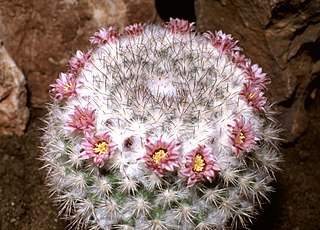
Mammillaria is one of the largest genera in the cactus family (Cactaceae), with currently 200 known species and varieties recognized. Most of the mammillaria are native to Mexico, but some come from the southwest United States, the Caribbean, Colombia, Venezuela, Guatemala and Honduras. The common name "pincushion cactus" refers to this and the closely related genus Escobaria.

Fishhook cactus is a common name for any hook-spined species of the genera Mammillaria, Echinomastus or Sclerocactus. They are small cacti, usually growing up to 6-7 inches (20 cm) high, and are shaped similar to a barrel cactus. They are not to be confused with the fishhook barrel cactus of the Sonoran and Chihuahuan Deserts. The Fishhook cactus is a large category of around 150 species.

Mammillaria dioica, also called the strawberry cactus, California fishhook cactus, strawberry pincushion or fishhook cactus, is a cactus species of the genus Mammillaria. Its common name in Spanish is biznaga llavina.

Mammillaria zeilmanniana is a species of cactus. It is endemic to Mexico, where it is known only from Guanajuato. It grows in a narrow canyon usually near water where there is high humidity, its total population is fewer than 250 individuals. It is threatened by illegal collection for the horticultural trade. Recent studies link this species to Mammillaria crinita.

Mammillaria polythele is a cactus in the genus Mammillaria, native to Mexico.

Mammillaria rhodantha, the rainbow pincushion, is a plant in the cactus family (Cactaceae) and is one of 171 species in the genus Mammillaria which are characterized by having nipple-shaped tubercles or prominences on their surface.

Mammillaria elongata, the gold lace cactus or ladyfinger cactus, is a species of flowering plant in the family Cactaceae, native to central Mexico. Growing to 15 cm (6 in) tall by 30 cm (12 in) wide, it consists of densely packed clusters of elongated oval stems, covered in harmless yellow or brown spines, and in spring producing white or yellow flowers. It is among the most common and most variable of its genus in nature, and is a popular subject for cultivation. It has gained the Royal Horticultural Society's Award of Garden Merit.

Mammillaria spinosissima, also known as the spiny pincushion cactus, is a species of flowering plant in the cactus family Cactaceae, endemic to the central Mexican states of Guerrero and Morelos, where they grow at elevations of approximately 1,600 to 1,900 metres. The species was described in 1838 by James Forbes, gardener of the Duke of Bedford. Botanist David Hunt collected a specimen in 1971, when he located one near Sierra de Tepoztlan, Mexico.

Cochemiea tetrancistra is a species of fishhook cactus known by the common name common fishhook cactus. It is native to the Mojave and Sonoran Deserts of northern Mexico and the southwestern United States, where it grows in a variety of desert habitat types.

Mammillaria carmenae, the Isla Carmen pincushion cactus, is a species of flowering plant in the family Cactaceae.

Mammillaria geminispina, the twin spined cactus, is a species of flowering plant in the family Cactaceae, native to central Mexico.

Mammillaria grahamii is a species of cactus also known by the name Graham's nipple cactus.

Mammillaria nivosa is a species of cactus also known by the name woolly nipple cactus and is native to the Caribbean.

Mammillaria bocasana is a species of cactus in the subfamily Cactoideae. It is often sold as a "powder puff" cactus, and also as a "Powder Puff Pincushion." The plant is protected from collecting in the wild in Mexico.

Mammillaria prolifera is a species of cactus in the subfamily Cactoideae, with the common name Texas nipple cactus.

Mammillaria lasiacantha is a species of cactus in the subfamily Cactoideae, with the common names lacespine nipple cactus, small pincushion cactus, and biznaga de espinas pubescentes (Spanish).

Mammillaria perezdelarosae is a cactus – a member of the family Cactaceae, placed in the tribe Cacteae. This cactus is common. It blooms with light pink and white flowers and is native to Jalisco, Mexico.

Mammillaria fraileana is one of about 200 species of the genus Mammillaria from the cactus family Cactaceae. This species is native to Mexico and can be found along the east coast of the southern part of Baja California Peninsula in Desert Scrub communities. They tend to grow in non-calcareous dry granite-based soil but can also grow in rocky habitats, either in rock fissures or directly on top of the rock surface even without the presence of soil. Thus, the mineral composition of the rocks in their habitat directly influence their abundance. The habitat of Mammillaria fraileana is home to succulent flora and is particularly rich in local endemics. Currently, no major threats to the species are known to exist.

Mammillaria sphaerica, the longmamma nipple cactus or pale mammillaria is a species of flowering plant in the cactus family Cactaceae, native to south eastern Texas in the USA and north eastern Mexico, where it occurs in scattered patches at altitudes up to 1,000 m (3,300 ft). It forms clumps of small pale green spheres to 5 cm (2.0 in) in diameter, with short hairs and pale yellow flowers up to 3 cm (1.2 in) wide in summer.

Mammillaria pringlei, called the lemon ball, is a species of cactus in the genus Mammillaria, native to Mexico, from Querétaro through to Veracruz and on to México State. It has gained the Royal Horticultural Society's Award of Garden Merit.




















